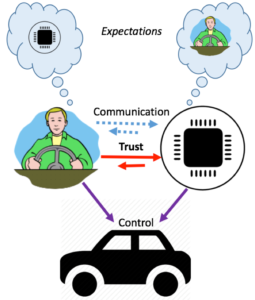
Autonomous and semi-autonomous vehicles have the potential to help drivers successfully and safely get from point A to point B while additionally providing the drivers with the flexibility to address other pressing issues not possible while driving manually. Drivers need to be comfortable relying on the vehicle’s autonomy in order to make appropriate decisions regarding when or when not to employ it. Unfortunately, drivers have failed to fully leverage a vehicle’s capabilities because of an inappropriate degree of trust in the vehicle’s autonomy. This manifests itself in misuse (for example, over reliance) or outright disuse of the vehicle’s capabilities, in either case increasing the risk of the driving task. The goal of this project is to develop methods to predict (1) when the human is likely to take or give control of the driving to the vehicle’s autonomy, and (2) when the vehicle’s autonomy should take or give control of the driving back to the driver. These methods focus on mutual and dynamic trust between the driver and the vehicle’s autonomy, and vice versa. For robustness, these methods contextualize (to the instantaneous driving situation) and personalize (to specific driver characteristics) the expectations underlying trust. The results of this study will provide new insights on how to better train drivers when they should employ a vehicle’s autonomy as well as allow designers of autonomy systems to design more effective controls that are more likely to be employed by drivers.
